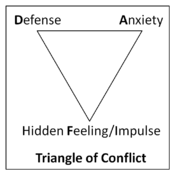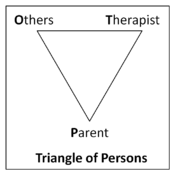David Malan (psychotherapist)
David Malan (born in India) was a British psychotherapist.
Biography
Malan was the son of an English father in the Indian Civil Service and an American mother. He spent the first eight years of his life in India. His father then died from pneumonia, and he moved to England and boarding school. His early love at school was ancient languages, Latin and Greek, but he later developed an interest in Chemistry which he then studied at the University of Oxford.
After the War he worked for Courtaulds as a research chemist for a year. During this time, he entered a short lived therapy with Hilda Stekel, Wilhelm Stekel’s widow, who carried on her husband’s tradition of intuitive brief psychotherapy based on dreams.
In 1947 he began a training analysis and a medical training at the same time. His first analyst was Michael Balint, whom he later left for Winnicott. After medical qualification, he worked first as a Casualty Officer, then at the Maudsley, and finally at the Tavistock Clinic, where he stayed for the rest of his professional career. There Balint invited him to be a founding member of his Workshop on Brief Psychotherapy. This gave him the opportunity to write a thesis for the Oxford postgraduate degree of DM. In this he was able to bring his scientific training to bear on issues in psychodynamic therapy. About this time he began work on his book Individual Psychotherapy and the Science of Psychodynamics. This was published in 1979. One of the most influential concepts introduced in the book were the Malan triangles which can be made the basis of almost every intervention that the therapist makes. It must be said, however, that what is widely known as Malan's Triangle(s) has not been created by him. Rather, it's a model of unconscious previously developed at Menninger Clinic, as Malan himself cites in the bibliography of his book Individual Psychotherapy and the Science of Psychodynamics.
In recent years Malan has continued his work collaborating with Patricia Coughlin (Della Selva), one of Davanloo’s former ex-trainees. Together they have written a book entitled "Lives Transformed" which show how modifications of Davanloos technique can contribute to significant change in a limited number of sessions. The extent to which these modifications have changed the character of the ISTDP therapy as presented by Davanloo (in Davanloo, H: "Intensive Short-Term Dynamic Psychotherapy", in: Kaplan H., and Sadock B. (eds), Comprehensive Textbook of Psychiatry, 8th ed, Vol 2, Chapter 30.9, 2628–2652, Lippincot Williams & Wilkins, Philadelphia, 2005) remains a matter of debate in the psychotherapy community.
Brief psychodynamic psychotherapy as developed by David Malan


This psychotherapy is time limited, the maximum number of sessions is 30.[1] The therapy is focussed in that the therapist concentrates on one theme and discusses this theme with the patient before the therapy begins. The focus can be a superficial conflict or a conflict that is deeply embedded in the patient’s life. The therapy has the best results if the conflict that is chosen is related to the central conflict from the patient’s childhood.[2] The therapist takes an active role during the therapy. He sees to it that the focus is the central theme in each session. Anything outside the focus is neglected, anything related to the focus is given attention to.[1] The therapist makes use of resistance, transference, countertransference and interpretation and uses the Malan triangles (see picture). These triangles are a picture of the structure of the patient’s conflict and of the persons related to that conflict.[3] The patient defends (defence mechanism) against the hidden feeling, expression of which to others in the present or to the parent in the past (origin of the conflict) is unacceptable and cause for anxiety. Both triangles stand on its apex. In the Triangle of Conflict (first used by Ezriel [4]) this means that the hidden feeling/impulse lies under the defence and the anxiety. In the Triangle of Persons (developed by Menninger [5] ) that what happened in the relation to the Parent lies under and is prior to what happens in relationship to Others or to the Therapist (transference). Malan linked both triangles: the hidden feeling is related to one or more categories of the Triangle of Persons. Nearly every intervention of the therapist is reflected in the triangles. The therapist needs to realise at every moment in the therapy which area of which triangle is at stake. The aim of the therapy is to give the patient insight into his behaviour pattern by working through the defence, bringing the hidden feeling/impulse into awareness, making clear how these have impacted the relationship of the patient with others in the present, with his parents in the past. Contra-indications for this therapy are very impulsive or self-destructive behaviour, serious attempts at suicide, long period of hospitalisation, electroshocks treatments, strong phobic or obsessive complaints (from a non-published list made by H.P.Hildebrand .
Publications
- Malan, D. (1999) Individual Psychotherapy and the Science of Psychodynamics (2nd edn). Oxford: Butterworth-Heinemann.
- Malan, D.& Della Selva, P C. Lives Transformed: How Psychodynamic Psychotherapy Works (2006), ISBN 1-85575-378-2,
See also
- Malan triangles
- Countertransference
- Defence mechanism
- Psychodynamics
- Psychodynamic psychotherapy
- Transference
References
- ↑ 1.0 1.1 Berk,T.(2001): Handboek korte psychodynamische psychotherapie. Boom, Amsterdam.
- ↑ Malan, D. (1976):The frontier of brief psychotherapy. New York: Plenum Medical Book Company.
- ↑ Malan, D. (1979) Individual psychotherapy and the science of psychodynamics. London, Butterworth
- ↑ Ezriel,H. (1952). Notes on psychoanalytic Group therapy: II .Interpretation. Research Psychiatry,15,119.
- ↑ Menninger, K. (1958). Theory of psychoanalytic technique. New York, Basic Books.